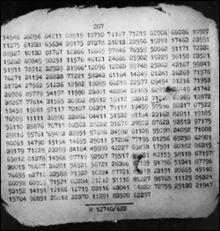Reino Häyhänen
Reino Häyhänen (born May 14, 1920 in Petrograd, today: Saint Petersburg , † 1961 in Pennsylvania ) was a Finnish-Russian agent spying for the Soviet Union ( aliases : Eugene Nicolai Mäki and VICTOR, abbreviation: VIC), who later moved to the United States defected.
Life


The son of a Finnish-Russian peasant family, Reino was born near Petrograd (today: Saint Petersburg) in 1920. Due to his family background and upbringing, he spoke not only fluent Russian but also Finnish . He was recruited by the Soviet Interior Ministry (NKVD) and worked as a translator for captured Finnish documents and as an interpreter during the interrogation of Finnish prisoners during the Finnish Winter War . After the war from 1940, one of his tasks was to check the reliability and loyalty of Soviet workers in Finland and to track down anti-Soviet persons there. Due to his services in these activities, Häyhänen was accepted into the CPSU in May 1943 . After the Second World War he worked as an intelligence officer for the NKGB . In the summer of 1948 he was called to Moscow by its successor organization, the KGB , where he met his future wife, Akulina Pavlova . The KGB trained him as a foreign spy. This included intensive training in English and training in typical agent tasks such as photography and cryptography .
During this time he worked as a camouflage mechanic in the Estonian town of Valga before moving to Finland via Porkkala in the summer of 1949 . This was done in preparation for his planned smuggling into the United States, under his new alias Eugene Nicolai Mäki, a seemingly American-born worker who actually existed but was previously missing in Finland.
After Häyhänen spied for a few years as an agent for the KGB in the USA during the Cold War , among other things as an employee of Rudolf Abel , he used a callback to Moscow to escape and defected to the Americans. During a stopover in Paris in May 1957, he turned to the American embassy there and revealed himself to the Americans. He was welcomed and allowed the FBI to gain some valuable new knowledge about the Soviet spy network and special intelligence methods. This included the disclosure of the so-called VIC cipher , a special encryption method of the KGB, the cryptanalysis of which the Americans had previously failed.
Reino Häyhänen died under mysterious circumstances, presumably in a traffic accident, on the Pennsylvania Turnpike in 1961.
literature
- David Kahn : The Code Breakers - The Story of Secret Writing . Macmillan USA, Reissue 1974, ISBN 0-02-560460-0
- Jozef Kollár: Soviet VIC Cipher - No Respector of Kerckoff's Principles . Cryptologia , Vol 40 (1), January 2016, pp. 33-48. doi : 10.1080 / 01611194.2015.1028679
- Fred B. Wrixon: Codes, Ciphers & Other Secret Languages - From Egyptian Hieroglyphics to Computer Cryptology . Könemann, Cologne 2000, p. 116 f. ISBN 3-8290-3888-7 .
Web links
- Photo by Reino Häyhänen . Retrieved January 21, 2016.
Individual evidence
- ^ Encyclopedia of Cold War (English). Retrieved January 21, 2016.
- ↑ Fred B. Wrixon: Codes, Ciphers & Other Secret Languages - From Egyptian Hieroglyphics to Computer Cryptology . Könemann, Cologne 2000, p. 116 f
- ↑ Hollow Nickel Case (English). Retrieved January 21, 2016.
| personal data | |
|---|---|
| SURNAME | Häyhänen, Reino |
| ALTERNATIVE NAMES | Mäki, Eugene Nicolai (code name); Victor (alias) |
| BRIEF DESCRIPTION | soviet agent |
| DATE OF BIRTH | May 14, 1920 |
| PLACE OF BIRTH | Petrograd |
| DATE OF DEATH | 1961 |
| Place of death | Pennsylvania Turnpike |